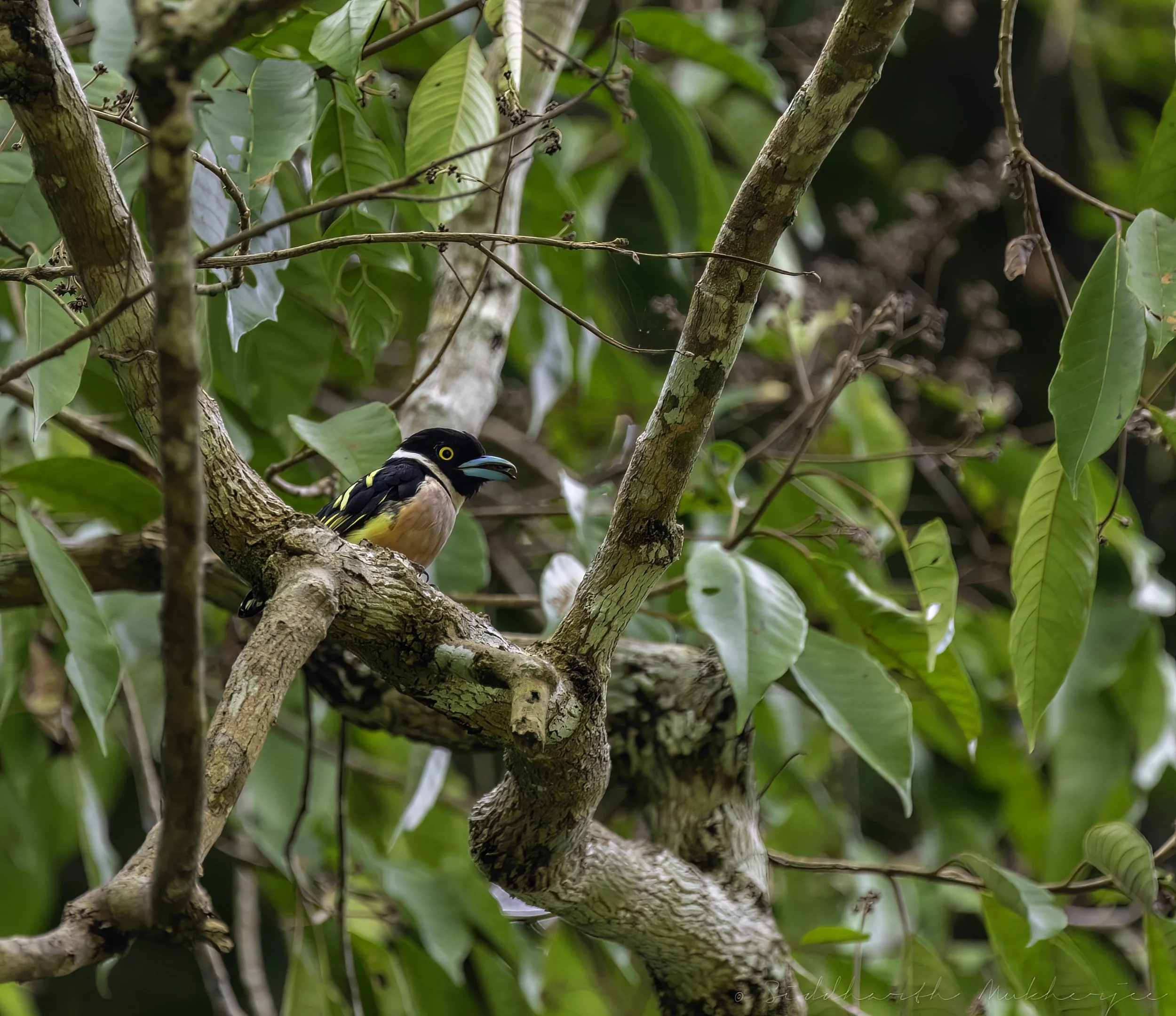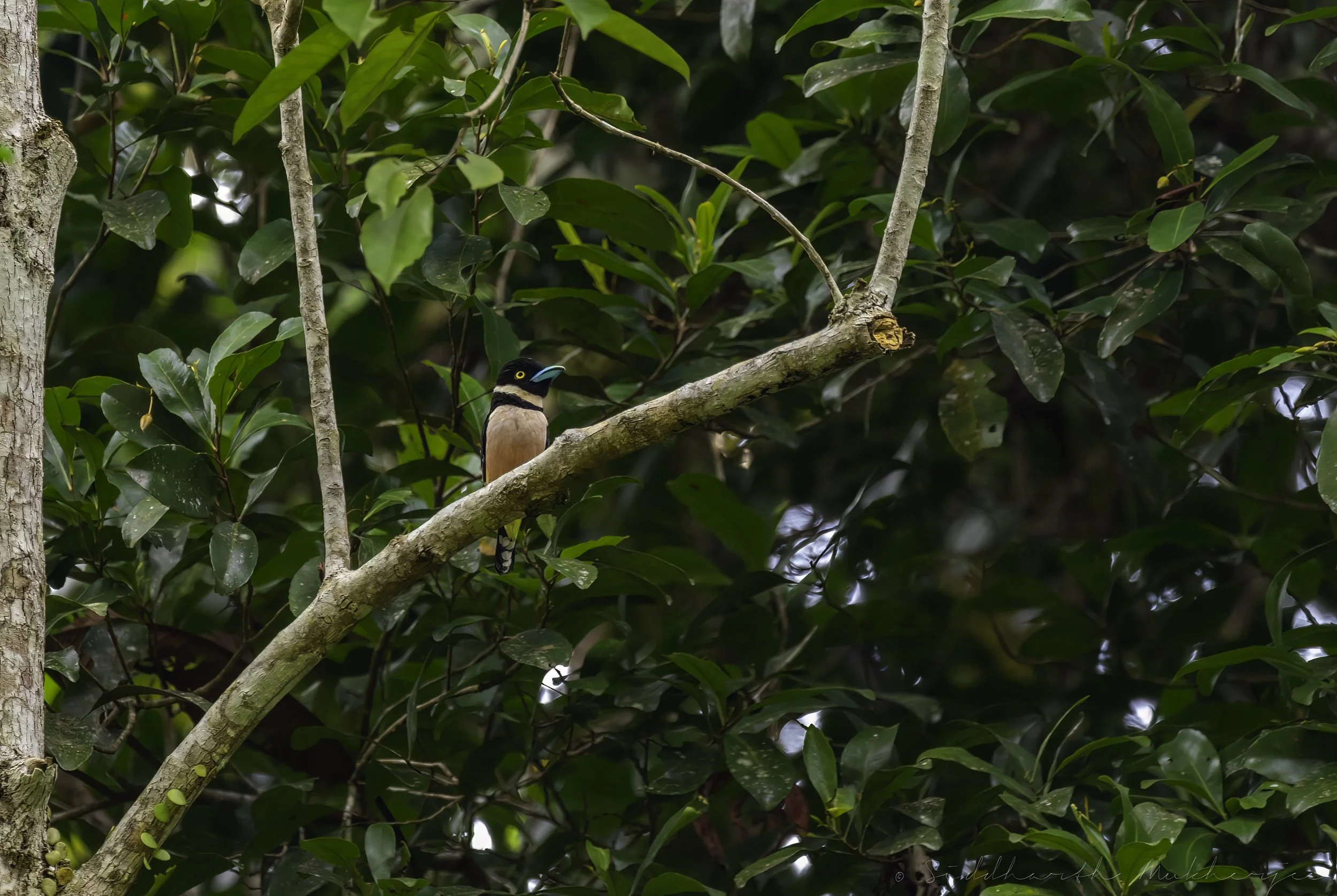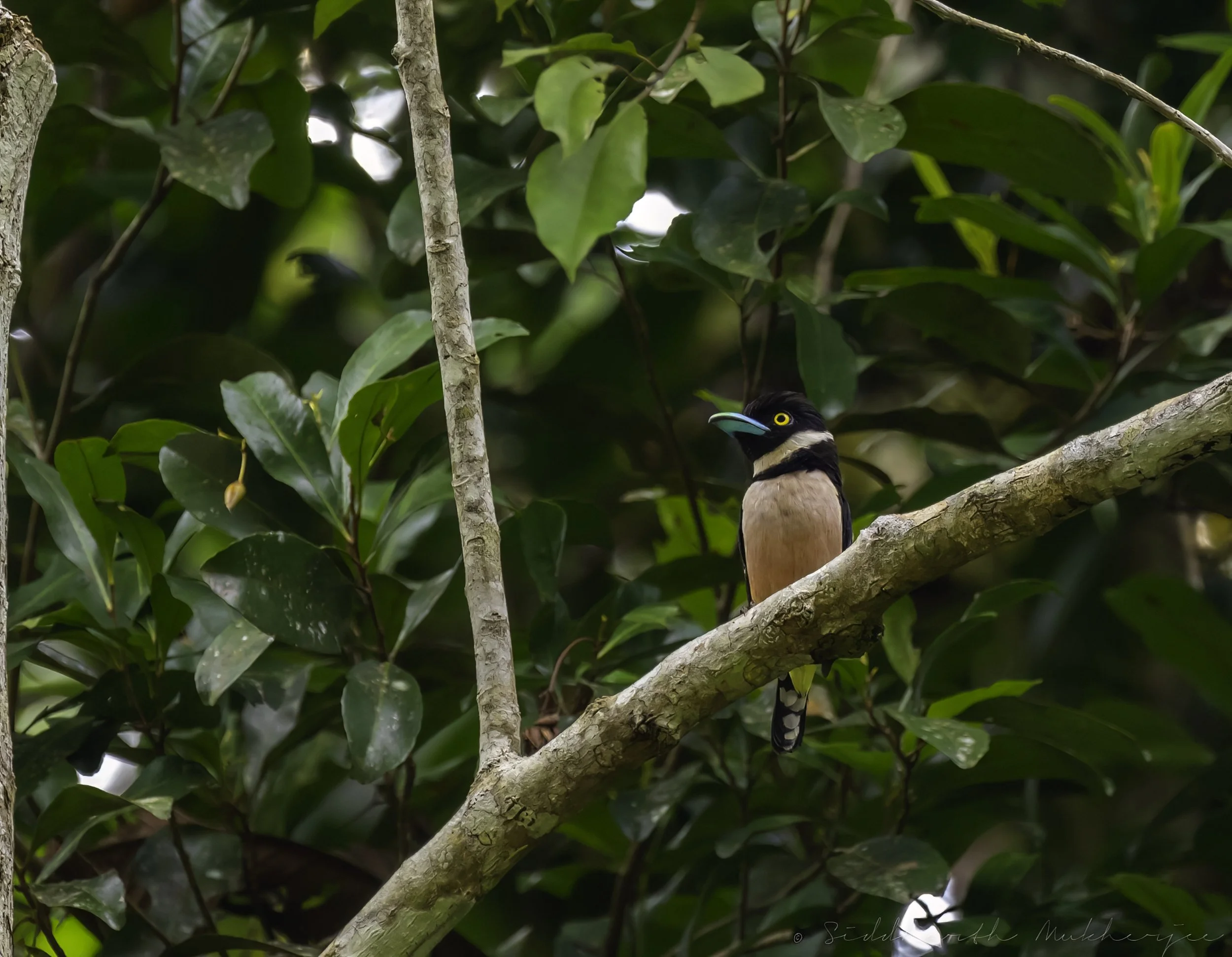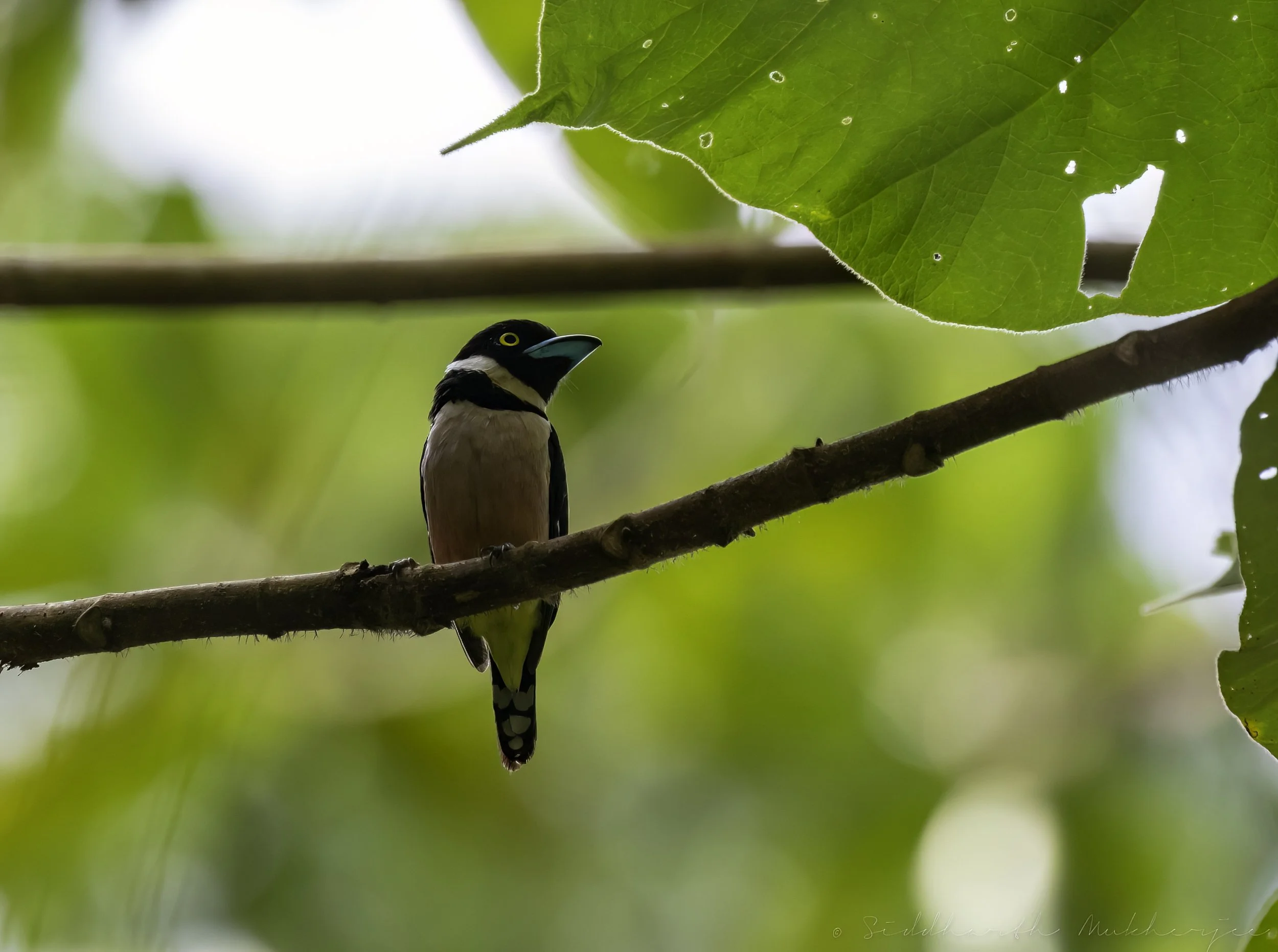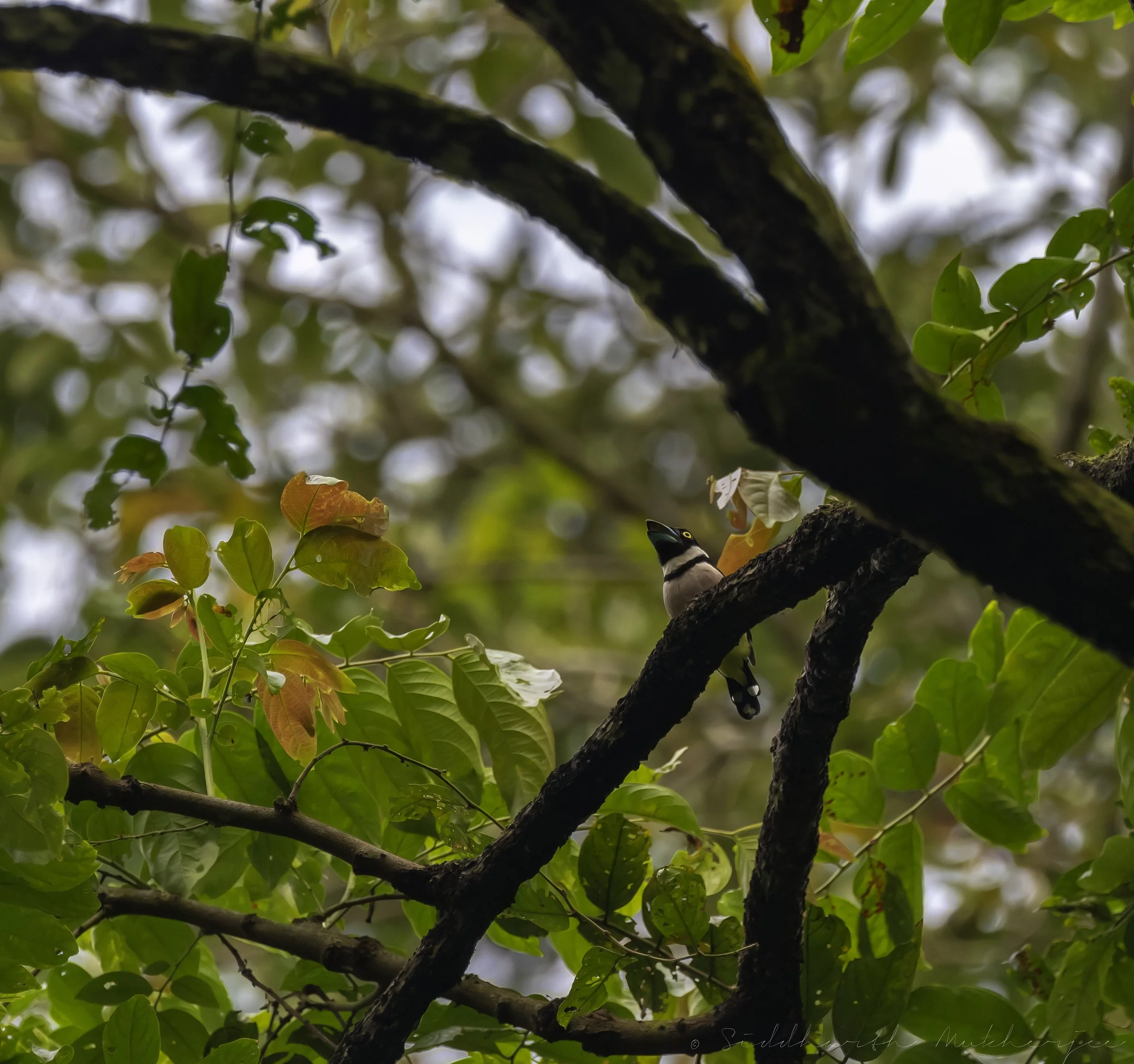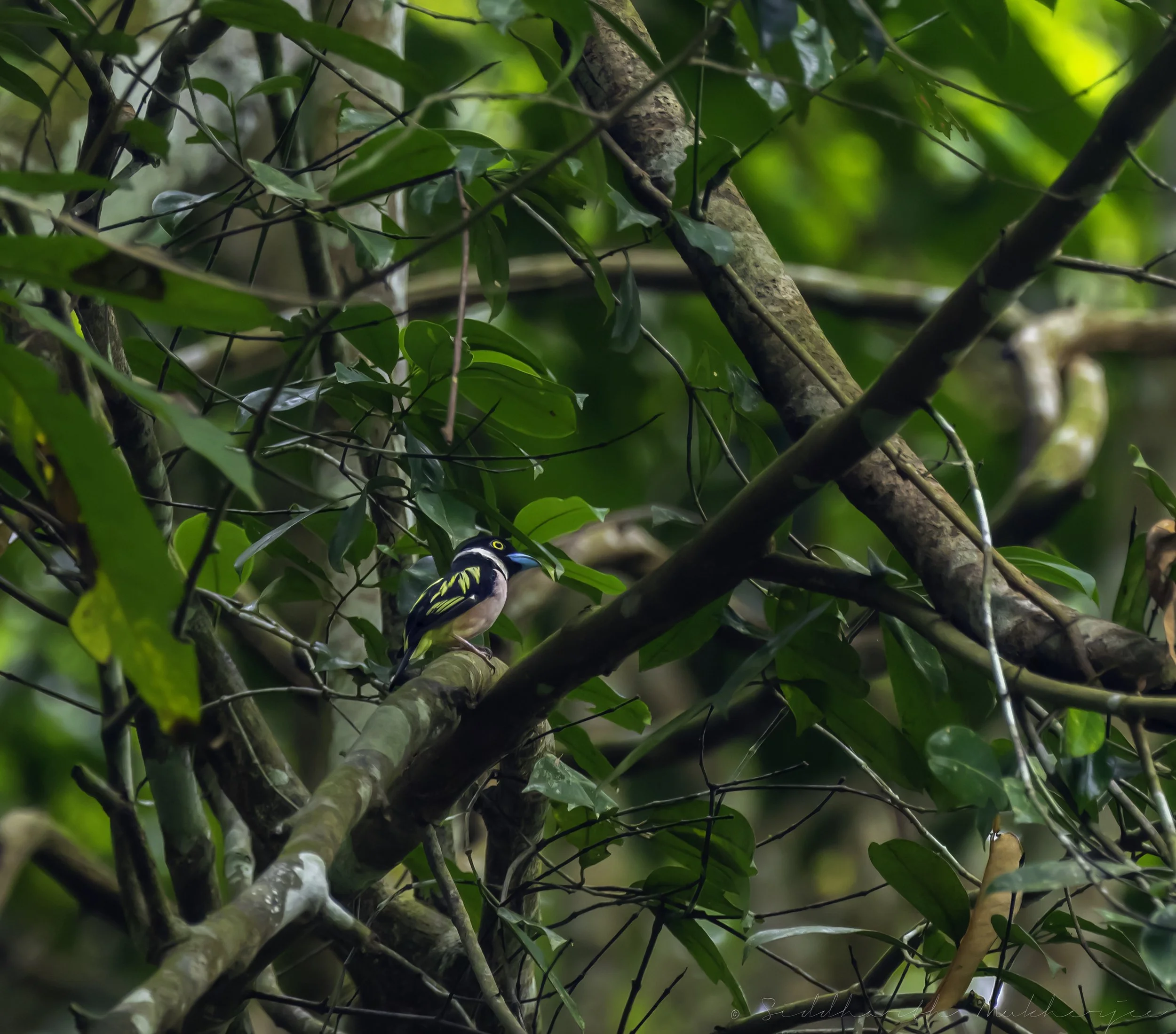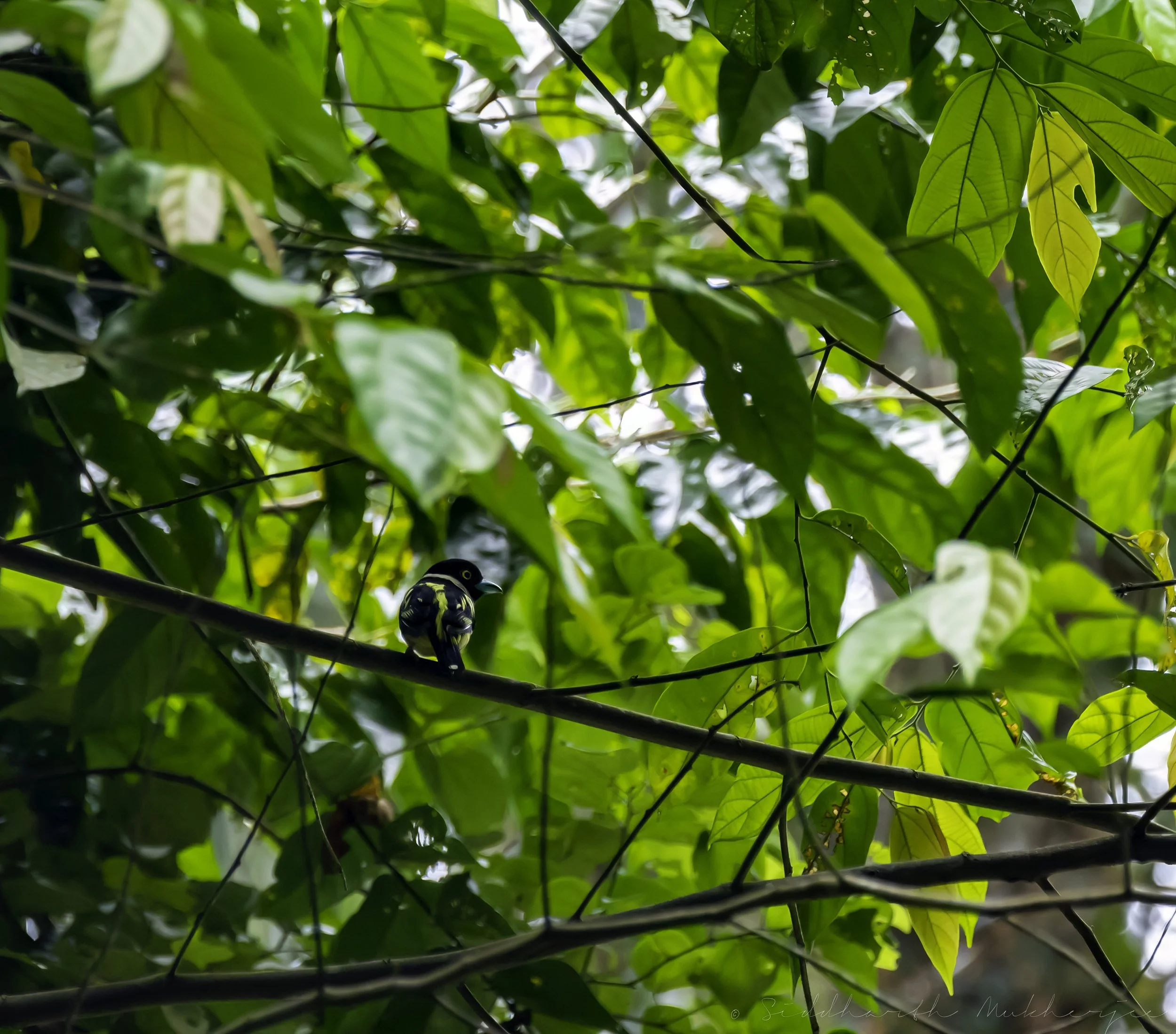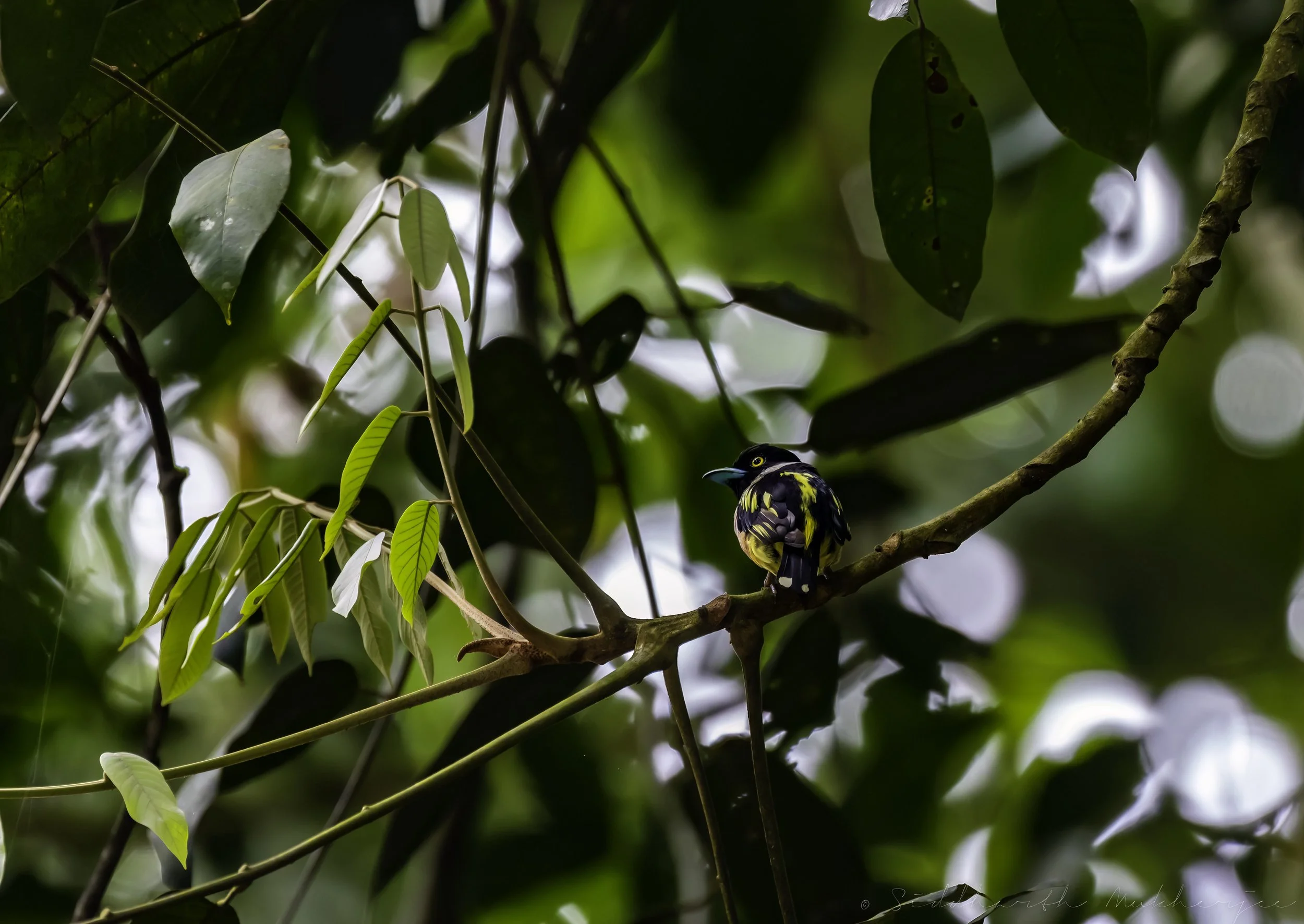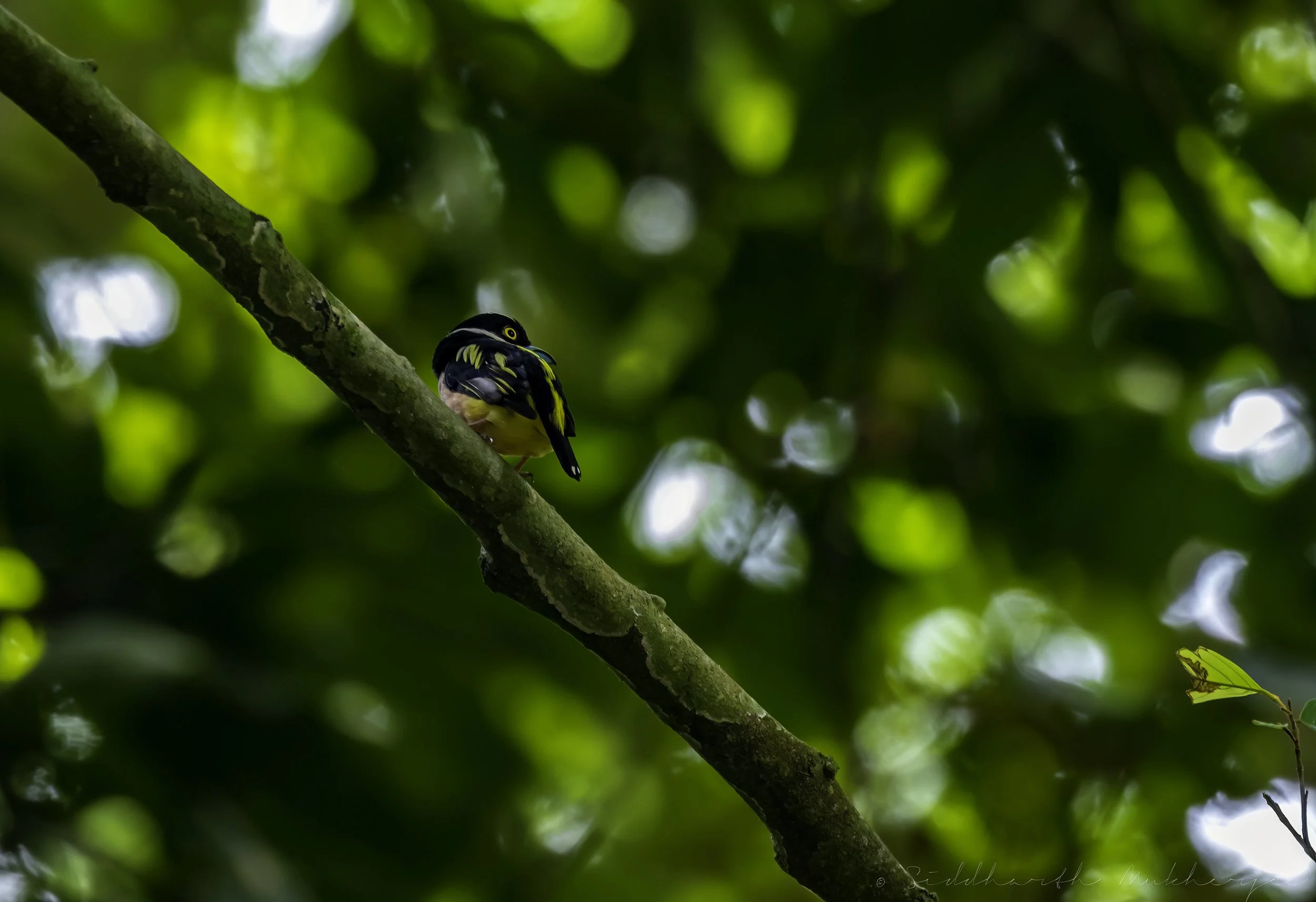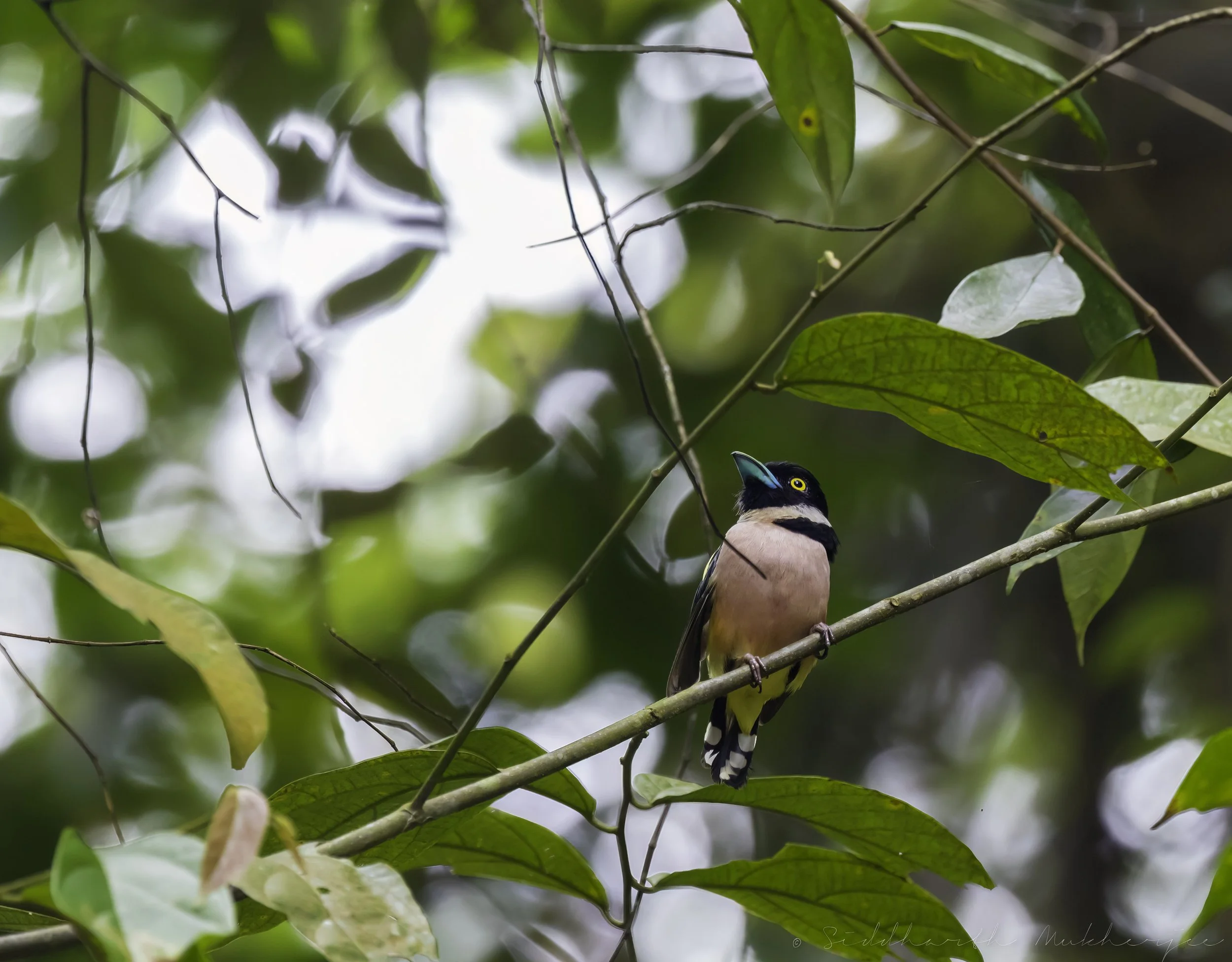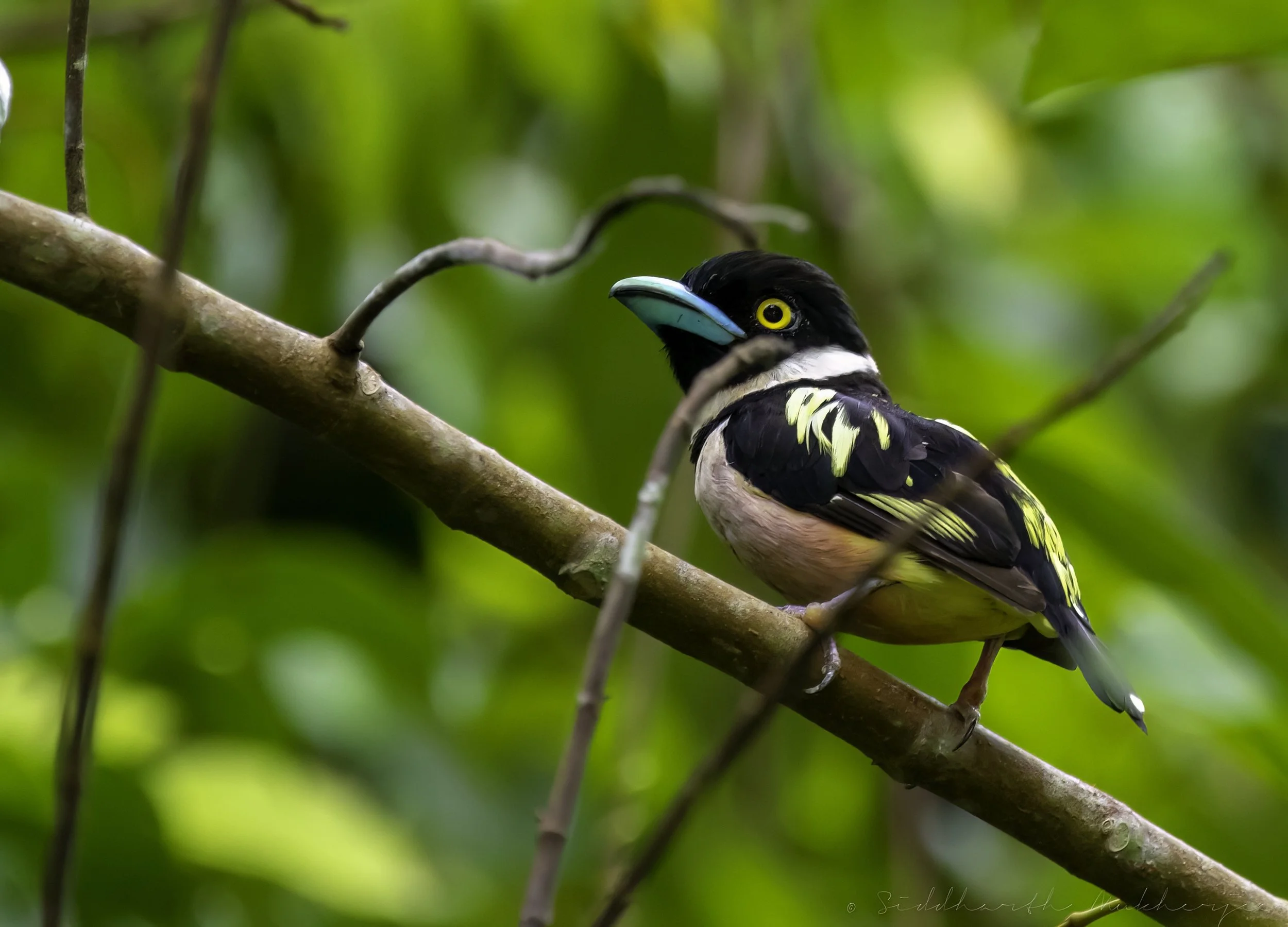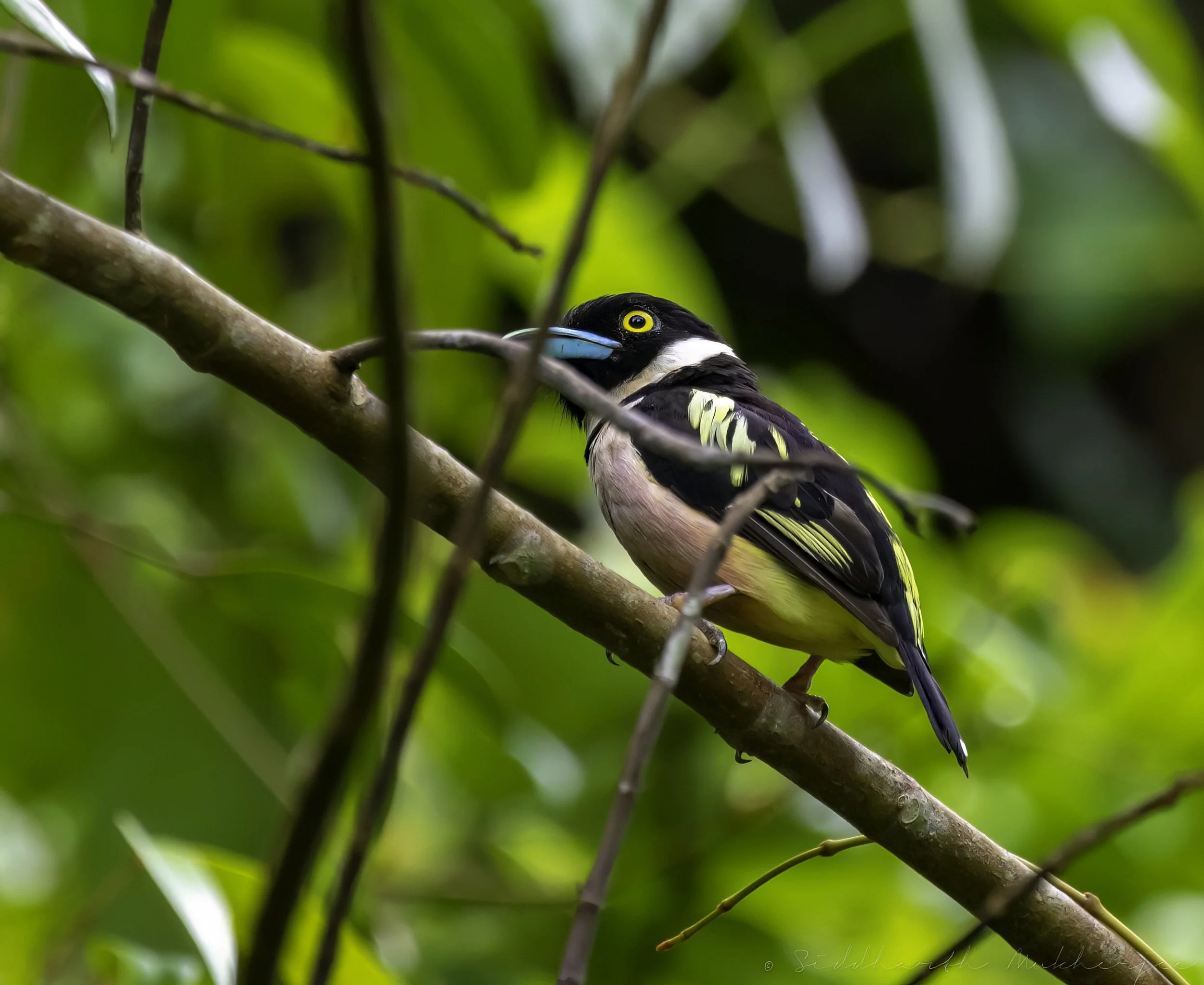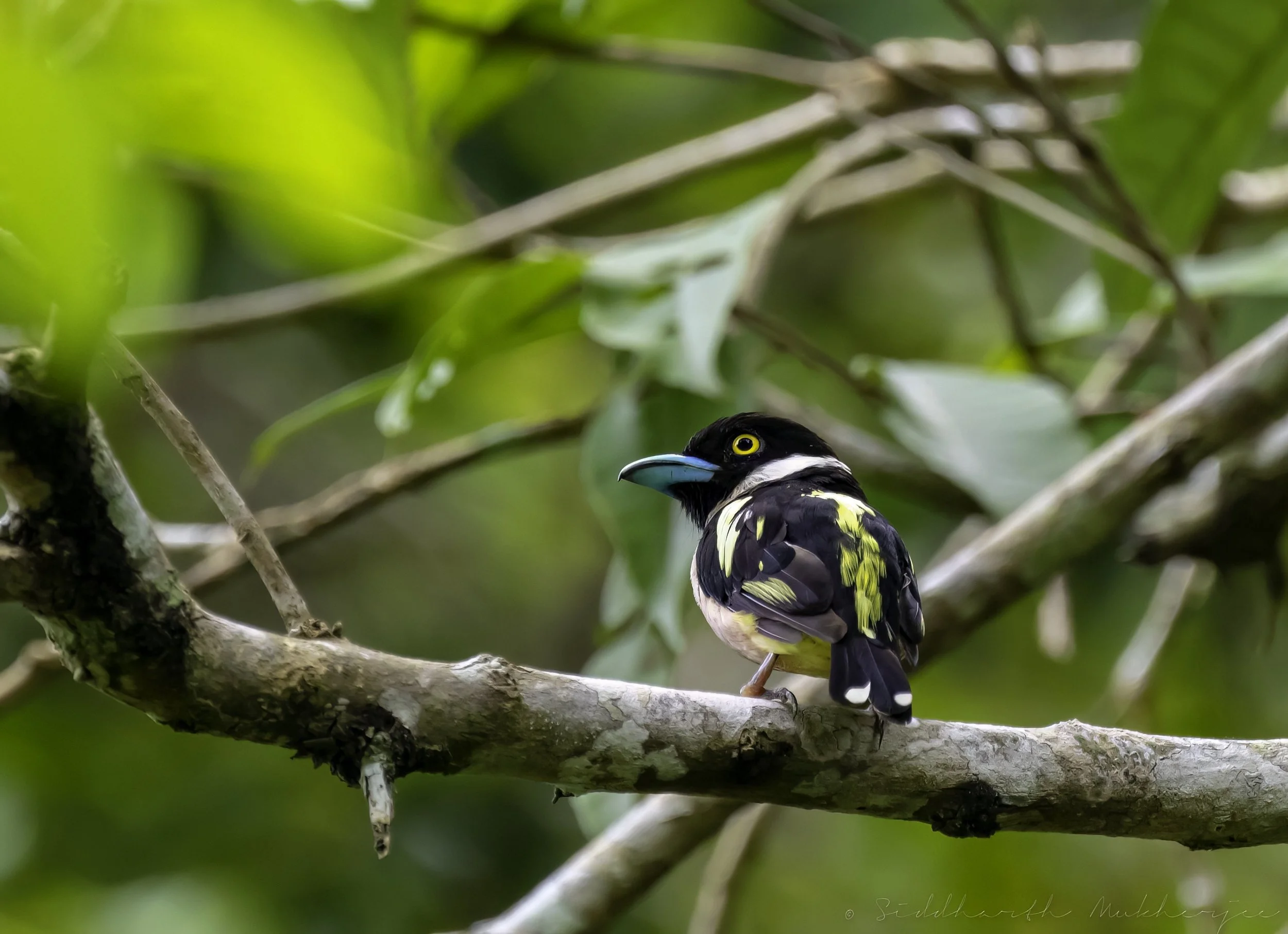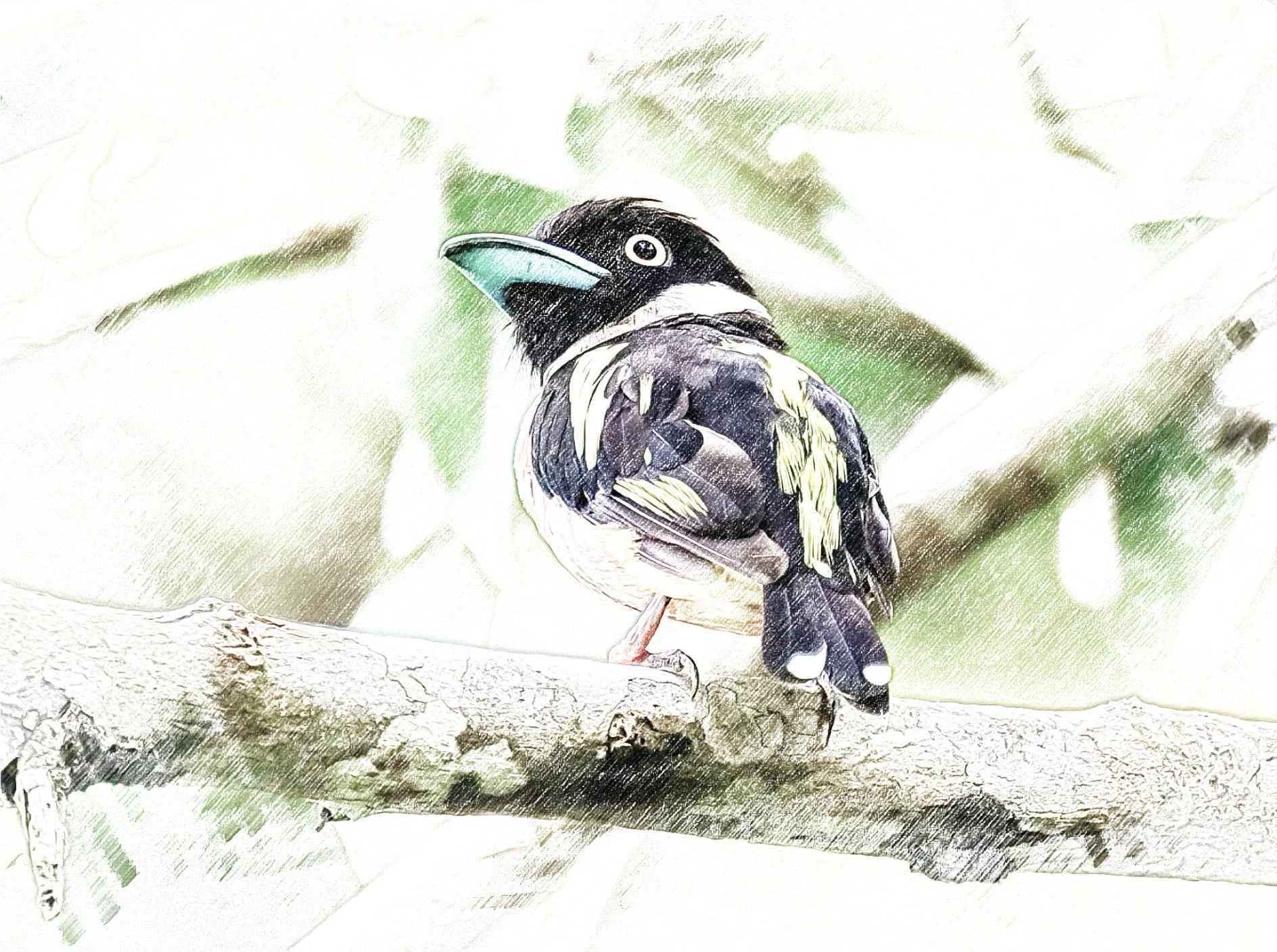Black-and-Yellow Broadbill
Eurylaimus ochromalus
NEAR THREATENED
Sungai Congkak & Lanchang, Malaysia & Kaeng Krachan National Park, Thailand
The Eurylaimidae are a family of suboscine passerine birds that occur from the eastern Himalayas to Indonesia and the Philippines. The family previously included the sapayoa from the Neotropics, the asities from Madagascar, and the Calyptomenidae from Africa, but these are now separated into distinct families. Many of the species are brightly coloured birds that present broad heads, large eyes and a hooked, flat and broad beak. They range from 13 to 28 cms in length, and live in the dense canopies of wet forests, allowing them to hide despite their brightly coloured plumage. The plumage of the juvenile eurylaimids are similar to those of the adults, differing in being duller and shorter-winged and shorter-tailed in some cases. They are for the most part insectivorous and carnivorous.
Eurylaimids feed on a broad variety of insects and invertebrates, especially large orthopterans and mantids, as well as small vertebrates (frogs, lizards, and even fish). Exceptionally, Grauer’s Broadbill (Pseudocalyptomena graueri) appears to be primarily frugivorous. Most broadbills acquire food by gleaning or during short sallying flights from perches.
There are four subfamilies of broadbills: Smithornithinae (typical African broadbills), Calyptomeninae (Asian green broadbills), Eurylaiminae (assorted Asian broadbills) and Pseudocalyptomeninae (Grauer’s broadbill). There are 9 genera and 14 species of broadbills. They are thought to be closely related to pittas (Pittidae) and asities (Philepittidae). They are primarily forest birds and live in rainforests of tropical Asia and Africa. Little is known about the mating behaviour of this group. Some species are thought to be monogamous, others polygynous and some may be cooperative breeders. During displays, many broadbills make a loud trilling sound with their wings that can be heard up to 60 m away. Most species are gregarious. Some species eat primarily insects while others mainly eat fruit. Here we will see one of the Eurylaiminae (assorted Asian broadbills).
The strikingly patterned broadbills of Asia are forest canopy birds, often revealed only by their throaty staccato calls. The bold contrasting swatches of black, yellow, and red or green in their plumage often extend into a very large and brightly coloured blue or silver bill, creating a visual impact to equal that of any other passerine in these forests. Their distinctive baglike nests are suspended by a long vine or tendril far beneath overhanging branches, and often over water or near a bee or wasp nest to protect the nest from tree-bound predators. As with the green broadbills, these Asian birds have a cousin in Africa with very different appearance, but we know very little about it.
They attach their purse-shaped nests to suspended vines, and leave a tail of fibres hanging below it. This gives the nest the appearance of being random debris caught in the tree, an effect further enhanced by the birds covering the nest with lichen and spider webs. Talk about camouflage!
Based on banding recaptures, broadbills are estimated to live at least 6 years in the wild. The oldest recorded bird in captivity was 19 years old.
‡‡‡‡‡
Conservation: Six out of 15 species are on the IUCN Red List. Three species are considered Vulnerable and three Near Threatened. With no more than 10,000 individuals each, the vulnerable species all have tiny ranges that are threatened by deforestation, mining activities, and/or guerilla warfare (on Mindanao, Philippines). Deforestation of lowland forest threatens Hose's, White-head's and Black-and-yellow (Eurylaimus ochromalus) broadbills.
Large areas of the wooded habitats of Asia have been harvested or converted to agriculture, creating conservation concerns for four (44%) eurylaimid species (1 NT, 3 VU). The three vulnerable species occupy very restricted ranges in the Philippines or in the Albertine Rift mountains of Africa, and the near-threatened species is limited to three areas in the Malay Archipelago.
‡‡‡‡‡
Read more about the other Broadbills I have photographed.
Sungai Congkak
About 35 kilometres from both Kuala Lumpur city center and Selangor’s Kajang town, lies the Sungai Congkak Recreational Forest, or Hutan Lipur Sungai Congkak. Also known as Chongkak Park & Resort, it is s a popular recreational forest in the Hulu Langat district of Selangor state and is managed by Tourism Selangor.
A dipterocarp rainforest that is part of the great Titiwangsa mountain range, Sungai Congkak Recreational Forest is rich in flora and fauna with meandering, crystal-clear rivers. Nestled in a cool and hilly area of Hulu Langat, the route leading to the forest passes through quaint towns and villages where the pace of life is noticeably slower.
Slightly deeper into Sungai Congkak Recreational Forest is the starting point of a challenging hiking trail to Bukit Chenuang (Chenuang Hill) which takes about an hour. Reaching an altitude of about 850 meters, the peak here provides great views of the surrounding valley. From Bukit Chenuang, one can continue hiking the trail to Bukit Batu Kumbang, which is about an hour away. The views of the Titiwangsa mountain range from the peak of Bukit Batu Kumbang make it a worthwhile hike.
Black-and-Yellow Broadbill
The Black-and-Yellow broadbill (Eurylaimus ochromalus) is a species of bird in the typical broadbill family Eurylaimidae. A small, distinctive species, it has a black head, breastband, and upperparts, a white neckband, yellow streaking on the back and wings, and vinous-pink underparts that turn yellow towards the belly. The beak is bright blue, with a green tip to the upper mandible and black edges. It shows some sexual dimorphism, with the black breastband being incomplete in females.
Native to Brunei, Indonesia, Malaysia, Myanmar, Singapore, and Thailand, it inhabits evergreen forest, dipterocarp forest, swamp forest, heath forest, and forest edges, along with secondary forest and plantations that contain large trees. Mainly inhabiting lowlands, the species is found up to elevations of 1,220 m. The black-and-yellow broadbill is mainly insectivorous, but also feeds on molluscs and incidentally takes fruit.
The black-and-yellow broadbill breeds during the dry season throughout its range, with both sexes helping build a large, untidy, pear-shaped nest out of moss, fungal mycelia, and leaves. Eggs are laid in clutches of two or three, sometimes containing a fourth runt egg, and are incubated by both sexes. The species is listed as near-threatened by the IUCN because of a decline in its population caused by habitat loss.
Status: Near Threatened
The Black-and-Yellow broadbill was described as Eurylaimus ochromalus by the British naturalist Stamford Raffles in 1822 based on specimens from Singapore. The generic name Eurylaimus comes from the Ancient Greek ευρυς (eurus), meaning broad, and λαιμος (laimos), meaning throat. The specific name ochromalus may come from either the Greek ōkhros, meaning pale yellow, and melas, meaning black, or ōkhromelas, meaning jaundiced. Black-and-Yellow broadbill is the official common name designated by the International Ornithologists' Union. Other common names for the species include black-and-white broadbill, black-and-yellow broadbill, and black-yellow broadbill. The species is called takau kasturi in Malay, Nok Phaya Paak Kwaang lek in Thai, and curɔɔw in Temiar.
The black-and-yellow broadbill is one of two species currently placed in the genus Eurylaimus, in the typical broadbill family Eurylamidae, a family of ten tropical species native to Southeast Asia. Based on a 2017 study by the Brazilian researcher Alexandre Selvatti and colleagues, its closest relative is the Banded Broadbill. These two species are most closely related to a clade formed by the Black-and-Red and Silver-breasted broadbills, and all three genera form a sister clade to the genus Sarcophanops. This clade is sister to one formed by the long-tailed broadbill and dusky broadbill. Both of these clades are sister to Grauer's broadbill. An earlier 2006 study by Robert Moyle and colleagues also found strong support for these relationships, but did not sample the wattled broadbill.
No subspecies of the Black-and-Yellow broadbill are currently recognised, but populations from the Banyak Islands and West Borneo have sometimes been treated as distinct subspecies named E. o. mecistus and E. o. kalamantan, respectively. However, all of the species' populations show significant variation in appearance between individuals, making the recognition of subspecies inadvisable.
The Black-and-Yellow broadbill is a small, distinctive species of typical broadbill that is 13.5–15 cm long and weighing between 31–39 g. Males have black heads and upperparts with a white collar and black breastband, along with prominent yellow markings on the back and wings. The underparts are vinous-pink, fading to yellow towards the belly and undertail coverts (tail feathers that cover the underside of the base of the tail). The tail is black, with yellow spots on the middle feathers and whiter ones on the outer feathers. The iris is pale yellow, while the bill is bright blue, with a green tip to the upper mandible and black edges. The base of the bill lacks bristles, which are present in some other species of broadbills. The legs are reddish, with long tarsometatarsi. The species shows some sexual dimorphism, with females having a gap in the centre of the black breastband. Juveniles lack a well-defined breastband and have a pale yellow supercilium (a stripe running from the beak to above the eye) with grayish-white underparts.
Reddish colours in the plumage of the black-and-yellow broadbill are caused by the biological pigment 2,3-didehydro-papilioerythrinone, which is also present in the feathers of the Banded broadbill, Black-and-Red broadbill, and Sarcophanops species. The yellow in the species' plumage is caused by the carotenoid 7,8-dihydro-3′-dehydro-lutein, which is also present in the plumage of the Banded broadbill.
Like other typical broadbills, the Black-and-Yellow broadbill has a large, wide bill that is thought to have first evolved in the common ancestor of all broadbills as an adaptation to an insectivorous diet. Its large and fleshy tongue helps manipulate objects inside its beak, allowing it to mash food against the inside of the beak to "chew" it.
The song is a cicada-like bubbling trill that starts with a few sharp downslurred notes before rising in pitch and gradually speeding up into an 8–12 second long low, quivering trill. This song is similar to that of a Banded broadbill, but is longer, accelerates more slowly, lacks an initial whistle, and ends suddenly. This song is given by a pair of birds, often calling alternately, while other individuals with the calling pair have been recorded giving a shrill, mournful peep. Other calls include a kor kor kor made by nesting males and a squeaky kyeeow.
They’ve also have been also observed singing and counter-singing (singing in response to another bird) and I have heard this behaviour both at Sungai Congkak & Kaeng Krachan National Park when close to other individuals, interspersing their songs with a throaty keowrr. The latter calls are also occasionally used during aggressive confrontations. You can listen to the birds calling and singing in the background in the video below. I was recording a beet webworm moth which had landed on my fingers and the two Black-and-Yellow birds were having a duet in the background.
The Black-and-Yellow broadbill is found in Malaysia, Thailand, Myanmar, Singapore, and Brunei. In Indonesia, it is found on the Riau Islands and the Lingga Islands, as well as on Borneo, Sumatra, Bangka Island, Belitung, and the Natuna Islands. It inhabits evergreen forest, mixed dipterocarp forest, fresh water and coastal swamp forests, heath forest, and forest edges, along with secondary forest and plantations, such as those of cocoa, rubber, and Albizia. Its presence in secondary forest and plantations depends on those areas having large remnant trees. The species is mostly found in lowlands, occurring at elevations up to 700 m (2,300 ft) in the Malay Peninsula, 900 m (3,000 ft) in Sumatra, and 1,220 m (4,000 ft) in Borneo.
The Black-and-Yellow broadbill is listed as being Near Threatened by the International Union for Conservation of Nature (IUCN) on the IUCN Red List. Its population is thought to be declining fairly quickly due to habitat loss caused by logging, land conversion, and wildfires. The effect of habitat loss on the species may have been reduced due to its tolerance of secondary forest. It was previously common throughout its range and is still locally common in areas with suitable habitat. It is likely to survive in the long-term only in protected areas and higher-lying forests in spite of its tolerance of degraded habitat.
‡‡‡‡‡
Related Posts

